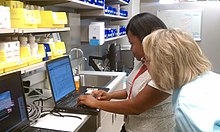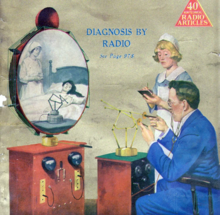Telehealth
[5] Telehealth could include two clinicians discussing a case over video conference; a robotic surgery occurring through remote access; physical therapy done via digital monitoring instruments, live feed and application combinations; tests being forwarded between facilities for interpretation by a higher specialist; home monitoring through continuous sending of patient health data; client to practitioner online conference; or even videophone interpretation during a consult.
Understanding the potential of telehealth to support therapeutic relationships between patients and health care professionals and being aware of the possible difficulties and tensions it may create are critical to its successful and acceptable use.
This approach allows patients in remote or underserved areas to receive pharmacy services that would otherwise be unavailable to them, enhancing access to care and ensuring continuity in medication management.
[47][48] A 2017 randomized controlled trial of "virtual house calls" or video visits with individuals diagnosed with Parkinson disease evidences patient preference for the remote specialist vs their local clinician after one year.
Each lecture provides fundamental principles, firsthand knowledge and evidenced-based methods for critical analysis of established clinical practice standards, and comparisons to newer advanced alternatives.
Therefore, they do not need particular workstations to view the images; a standard personal computer (PC) and digital subscriber line (DSL) connection is enough to reach Keosys' central server.
Teledermatology allows dermatology consultations over a distance using audio, visual and data communication, and has been found to improve efficiency, access to specialty care, and patient satisfaction.
Today, applications of teleophthalmology encompass access to eye specialists for patients in remote areas, ophthalmic disease screening, diagnosis and monitoring; as well as distant learning.
[95] In the United States, some companies allow patients to complete an online visual exam and within 24 hours receive a prescription from an optometrist valid for eyeglasses, contact lenses, or both.
The TelAbortion study conducted by Gynuity Health Projects, with special approval from the U.S. Food and Drug Administration (FDA), aims to increase access to medical abortion care without requiring an in-person visit to a clinic.
This included providing services to pediatric patients during the pandemic, where issues of last minute cancelation and rescheduling were frequently related to a lack of technicality and engagement, two factors often understudied in the literature.
[114] On March 31, 2020, QuickMD became the first national TeleMAT service in the United States to provide Medication-assisted Treatment with Suboxone online – without the need of an in-person visit; with others announcing to follow soon.
A 2023 study published in the Journal of the American College of Surgeons showed telemedicine as making a positive impact, with expectations exceeded for those physicians and patients who had consulted online for surgeries.
[134] Technological developments in telehealth are essential to improve health care, especially the delivery of healthcare services, as resources are finite along with an ageing population that is living longer.
These efforts can now be more personalised to the target population and professionals can extend their help into homes or private and safe environments in which patients of individuals can practice, ask and gain health information.
[150][151] Widespread breastfeeding can prevent 820,000 infant deaths globally but the practice is often stopped prematurely or intents to do are disrupted due to lack of social support, know-how or other factors.
[167] A review lists a number of potentially good practices and pitfalls, recommending the use of "virtual handshakes" for confirming identity, taking consent for conducting remote consultation over a conventional meeting, and professional standardized norms for protecting patient privacy and confidentiality.
[168] It also found that the COVID-19 pandemic substantially increased, voluntarily, the adoption of telephone or video consultation and suggests that telemedicine technology "is a key factor in delivery of health care in the future".
[173] In Alaska the Federal Health Care Access Network, which connects 3,000 healthcare providers to communities, engaged in 160,000 telehealth consultations from 2001 and saved the state $8.5 million in travel costs for just Medicaid patients.
Therefore, the growing prominence of telehealth is starting to underscore the need for updated regulations, guidelines and legislation which reflect the current and future trends of healthcare practices.
As with the Swedish online medical advice service,[203] one-sixth of the requests related to often shameful and stigmatised diseases of the genitals, gastrointestinal tract, sexually transmitted infections, obesity and mental disorders.
For example, the difficult financial situation in many African states and lack of trained health professionals has meant that the majority of the people in sub-Saharan Africa are badly disadvantaged in medical care, and in remote areas with low population density, direct healthcare provision is often very poor[205] However, provision of telemedicine and eHealth from urban centers or from other countries is hampered by the lack of communications infrastructure, with no landline phone or broadband internet connection, little or no mobile connectivity, and often not even a reliable electricity supply.
[207] The Board of Governors entasked by the Health Ministry published an amendment to the Indian Medical Council (Professional Conduct, Etiquette and Ethics) Regulations, 2002 that gave much-needed statutory support for the practice of telemedicine in India.
The earliest telehealth encounter can be traced to Alexander Graham Bell in 1876, when he used his early telephone as a means of getting help from his assistant Mr. Watson after he spilt acid on his trousers.
[220] In 1925 the inventor Hugo Gernsback wrote an article for the magazine Science and Invention which included a prediction of a future where patients could be treated remotely by doctors through a device he called a "teledactyl".
[219][228] The airport began seeing over a hundred patients a day at its nurse-run clinic that cared for victims of plane crashes and other accidents, taking vital signs, electrocardiograms, and video images that were sent to Massachusetts General.
In 1964, the Nebraska Psychiatric Institute began using television links to form two-way communication with the Norfolk State Hospital which was 112 miles away for the education and consultation purposes between clinicians in the two locations.
[236] The first interactive telemedicine system, operating over standard telephone lines, designed to remotely diagnose and treat patients requiring cardiac resuscitation (defibrillation) was developed and launched by an American company, MedPhone Corporation, in 1989.
[13] Increased access to portable devices, like laptops and mobile phones, made telehealth more plausible; the industry then expanded into health promotion, prevention and education.
[1][3][126] In 2002, G. Byron Brooks, a former NASA surgeon and engineer who had also helped manage the UTMB Telemedicine program, co-founded Teladoc in Dallas, Texas, which was then launched in 2005 as the first national telehealth provider.










